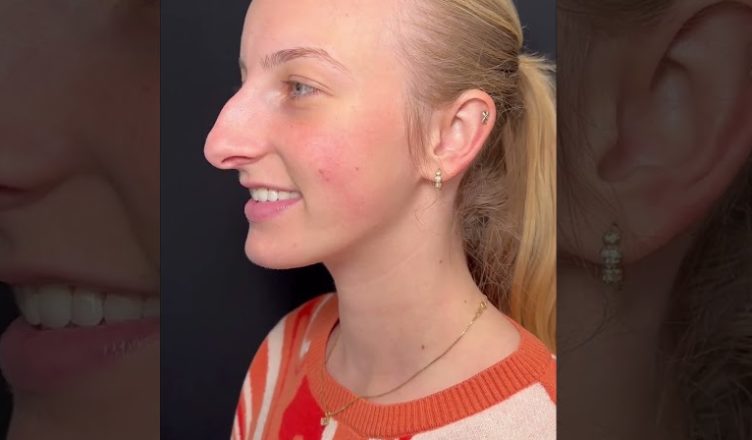It started like any other viral clip—harmless, captivating, and easy to scroll past.
A 30-second YouTube Shorts video uploaded by a modest channel named @TrueGlow. The title read:
“Before & After Nose Job: You Won’t Believe the Transformation.”
And it wasn’t clickbait.
The video began with a soft-focus shot of a young woman, her face framed gently by waves of dark hair. Her nose had a distinctive bump—not unattractive, but prominent. She looked into the camera with a shy smile.
Captions appeared:
“Before Rhinoplasty – Day 0.”
Nothing unusual.
But what followed would unravel the fabric of reality for thousands of viewers.
By Day 7, the video showed the bandages removed. Her eyes were still swollen, but the basic reshaping was evident. Her nose now appeared more streamlined, elegant.
Then came Day 21.
She looked radiant. Her nose slimmer, her features more balanced, her confidence suddenly cinematic.
The comments exploded:
“She looks like a movie star now!”
“This isn’t just surgery—it’s sorcery.”
“Her energy shifted. Anyone else feel it?”
Within a week, the clip hit 15 million views.
But it didn’t stop there.
New comments began to appear, strange ones:
“Why did she wink at me?”
“Watch her eyes in slow motion at 0:23… they flicker.”
“My mirror cracked when I paused it—WTH?!”
Some claimed the woman moved differently every time they rewatched it.
Others reported odd effects after viewing—nausea, lucid dreams, or the sense that they were being watched.
Theories ranged from clever editing to subliminal hypnosis.
And then people started disappearing.
It began with Hannah Voss, a beauty influencer who stitched the clip on TikTok, praising the transformation. She posted her reaction and promised a breakdown of the “surgery steps.”
Two days later, she vanished. Her final Instagram Story—uploaded at 2:13 a.m.—was a shaky, dark video of her whispering, “She’s not just changing herself… she’s changing us.”
Gone.
Next was a plastic surgeon in Dubai, who claimed in a podcast that the transformation was “anatomically impossible.” He laughed it off, called it “CGI nonsense.”
He was found unconscious in his office, mirrors smashed around him.
Authorities reported his last words before collapsing were:
“The reflection moved first.”
The woman from the video remained anonymous—no name, no credit, no tag. Internet sleuths reverse-searched every frame. Nothing. No trace of the clinic. No metadata. No past.
It was as if the before version of her never existed.
Until a user on a fringe forum posted this:
“I saw her. In real life. At a train station in Prague. She looked just like the After, but… wrong. Like she was glitching. Her reflection didn’t match her walk.”
That post, too, was deleted hours later. The user’s profile disappeared.
The story was now bigger than plastic surgery.
It was becoming an urban legend.
A code buried in a viral clip. A transformation that didn’t just alter appearance—but identity, memory, and perception.
That’s when Leo Marquez, a freelance programmer obsessed with digital anomalies, decided to extract the source frames of the video.
What he found changed everything.
There were exactly 666 frames.
But frame 341 didn’t match the rest.
It was darker, blurred. When Leo isolated and enhanced it, he saw something buried in the pixels:
A room. Walls covered in mirrors.
And in the center—not one woman, but dozens, each version slightly different. Some smiling. Others crying. One… staring directly into the camera.
Her nose was gone.
Completely smooth.
Beneath the image, a series of binary code.
Leo translated it.
It read:
“WE ARE NOT BEAUTIFUL. WE ARE MANY.
YOU SAW ME.
NOW I SEE YOU.”
An hour later, Leo live-streamed himself explaining the find. Halfway through, his camera froze mid-sentence. The last frame showed his reflection standing… without him.
A digital researcher dubbed the phenomenon The Mirror Code.
The theory: the viral nose job video wasn’t created to show beauty—it was a gateway.
Each view, each pause, each rewind allowed a sliver of something from “the other side” to see us.
The transformation wasn’t just physical.
It was dimensional migration.
The woman in the clip? She wasn’t changing for confidence. She was becoming a host. Adopting our form. Testing the boundaries of visual entry.
The nose—the one part of the human face that can’t be perfectly duplicated in AI-generated imagery—had to go.
It was the final key.
Today, that video is nearly impossible to find. YouTube removed it. Reddit banned threads. Even Wayback Machine refuses to cache the link.
But fragments still exist.
Those who downloaded it early often report the same thing: when they look into a mirror, they sometimes see someone else looking back—someone familiar, but slightly… refined.
Someone with a perfect nose.
And a smile that doesn’t reach the eyes.
A popular conspiracy now circulates:
“There are two kinds of people left—those who’ve seen the video, and those who still exist.”
YouTube never commented officially.
But an anonymous former employee leaked an internal flag that was added to the original clip:
“AI-Tag: Extrareality Infiltration Risk – Priority Red”
The tag has only been used once.
For that video.
For her.
The woman whose transformation captured the world…
…and opened the door.
